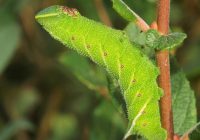Dr Phil Smith’s Wildlife Notes
August 2013
It was the warmest August since 2004 and the driest and sunniest since 2007, welcome news for our hard-pressed butterflies and other insects. As usual, Graylings were a feature of the frontal dunes along the coast, nectaring especially on Sea Holly. At last, Small Coppers began to appear in reasonable numbers, with ten on Ragwort at Freshfield Dune Heath Nature Reserve on 3rd, together with 10 other butterfly species, including a Holly Blue. Another visit to this superb reserve on 8th produced both Common and Slender Groundhoppers, together with an abundance of the Mottled Grasshopper, a real favourite of mine that comes in about a dozen colour-forms. Several people reported Wall Browns in the dunes from the second week and I certainly saw more than usual of this nationally declining species, which has been lost from many inland localities. Then, late in the month, second-brood Small Heaths put in a welcome appearance.
Several trips were made to slack 47 in the Birkdale frontals where three scrapes were restored in March 2012 to improve their condition for wildlife, including dragonflies. By recording both the variety and numbers of these insects, I hope to show whether the work has been worthwhile. So far, the omens are good with 12 species identified and several doing particularly well. Thus, I had peak counts of 109 Emerald Damselflies and 36 Common Darters on 22nd. However, numbers of Ruddy Darters were down with a maximum of only two. This species likes densely vegetated pools, so they should increase as the plant life develops.
Pinfold Pond in Ainsdale NNR is also good for dragonflies, Ruddy Darter and Southern Hawker being spotted on 21st, the latter showing its inquisitive nature by flying over to inspect me. However, the new boardwalk around the pond is attracting dog-walkers who allow their pets to dive into the water, completely inappropriate behaviour in a National Nature Reserve.
Much of my time this month was spent organising with Merseyside BioBank and taking part in the coastwide Grass-of-Parnassus survey. No less than 43 volunteers have been recruited to find out how much of this plant we have, where it grows and what conditions it likes. With its big starry white flowers, this is an iconic species for the Sefton Coast, much appreciated since Victorian times. It is declining nationally and there may be more of it in our dune-slacks than anywhere else in the country. We need to know much more about this glorious plant so that it can be conserved for future generations to enjoy.
I also undertook my own survey of a much less attractive plant, Blunt-flowered Rush, a mainly southern species in Britain, scarce in the Northwest. Despite an abundance of apparently suitable wet-slack habitat, it is only known from six sites on the Sefton dunes where it forms dense patches. Why it doesn’t spread further is one of the questions I am trying to answer.
There was little time for bird-watching during August but I bumped into an immature male Redstart at Hightown dunes on 16th. Liverpool Bay is an important staging post for terns from many parts of Britain before they set off on their epic autumn migration to western and southern Africa. Noisy Sandwich Terns regularly roost on Ainsdale beach in August and I counted a record number (for me) of 490 on 12th. However, a similar flock on 23rd was repeatedly and deliberately flushed by a couple with a camera. It was a disreputable performance! Perhaps it was lucky I didn’t catch up with them, as my language might not have been entirely diplomatic.
Finally, a visit with Trevor Davenport to the Birkdale Green Beach and adjacent frontal dunes on 28th was rewarded with some spectacular caterpillars of Dark Tussock, Buff-tip and Eyed Hawk Moth, a reminder of the extraordinary diversity of small creatures to be found on our wonderful coastline.




